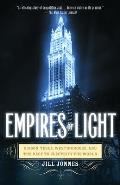
In Empires of Light, the story of Thomas Alva Edison, George Westinghouse, Nikola Tesla and the “War of the Currents,” Jill Jonnes has written a book that is entertaining as well as highly informative.
Jonnes did a prodigious amount of research, but her goal was to write a readable book, and she doesn’t drown us in academic discoveries. Her extensive Notes section, a thorough Index and bibliography section should provide enough for the scholar. (I actually ordered two books based on her bibliography.) The book doesn’t read quite like a novel, but these men – these characters – are larger than everyday life, and Jonnes gets out of their way and lets their story unfold.
Edison is known as the father of electricity, but his big contribution to the process was the incandescent light bulb (no small thing). Edison was the first to bring electric lighting to the city of New York in any major way. Edison loved direct current, a charge that ran only in one direction rather than in pulses like alternating current; but direct current was expensive to transport over copper wire any distance; so the uber-wealthy who wanted electric lights added boilers and generators to their property. This made DC expensive anywhere outside of a dense urban area. Edison’s vision was probably thousands of small power plants generating juice for the nearby businesses and homes. Clearly he hadn’t given much, if any, thought to rural areas.
Westinghouse realized that alternating current could be pushed through copper wire longer distances. The drawback to alternating current was that nobody, yet, had an efficient electric motor that didn’t throw sparks.
Enter Nikola Tesla; the father of radio, and the inventor of the electric motor, an enigmatic Croatian, the shy genius who was best known in his lifetime as a wonderful showman who ended his “lectures” on electricity by wreathing his body in sparks. Tesla probably understood electricity better than either of the other two – or, maybe, better than anybody, ever — but he had the true curse of a genius. Tesla wasn’t a year or two ahead of everybody else; he was decades ahead in his thinking, which meant that people couldn’t understand what he was talking about.
George Westinghouse was one of the Long Gilded Ages millionaires. I was surprised to find out just how progressive he was. He paid his workers a fair wage; he compensated inventors very well. He was a genial, calm and ruthless competitor. Edison, on the other hand, was a showman, content to take credit for the breakthroughs others made, and a union-buster. Both men personally, however, engendered great loyalty; both men were willing to roll up their sleeves and plunge into the work when it needed doing. When Edison was running underground wire to light a neighborhood in New York, he was there every day checking the work and sometimes climbing into the trenches to see what was what.
Jonnes makes the technical aspects of electricity simple and accessible. About a third of the book focuses on the legal and patent wars between Westinghouse and Edison, and the vicious media battle fought over alternating current. Edison hated AC. Part of his hatred seems to stem from a sincere belief that the higher ampage was dangerous (“a deadly current” he called it); part of his animus seems to come from the fact that he started working with DC and didn’t want to change. Tesla, who worked for Edison for several years, finally left because he could not get Edison to show an interest in his AC electric motor. Westinghouse, on the other hand, was very interested.
The book makes a detour to follow one of the most bizarre aspects of the Current Wars; the invention of the electric chair and the argument over DC or AC current. Edison and a strange champion of DC named Brown, who came out of nowhere, argued that DC would not consistently kill a person. Brown staged “demonstrations” where he electrocuted animals to show how more efficient AC was at killing. (Did you say “Ick!” just there? Apparently, so did many members of Brown’s audiences. The SPCA finally made him stop.)
Westinghouse argued that AC didn’t kill consistently either. Yes, this was the actual argument. I can’t do this whole gnarled political, propagandist, random story full justice, except to say that I fell really, really, really bad for the poor murderer who actually did die in the first electric chair.
Contrasting with the twisted darkness (pun intended) of the “death current” debate is Westinghouse’s triumph at the 1893 Chicago Exhibition; and the genuinely amazing Niagara Power Project.
Jonnes weaves in the economic turbulence of the time, and points out how incidents across the globe had an impact, such as the attempt of a man with the unlikely name of Hyacinth Secretan to corner the copper market. (And why hasn’t some steam-punk writer put Secretan into a novel? That’s my question.)
Both Westinghouse and Edison lost their electrical companies to the “money-men;” Westinghouse to the bankers he was forced to add to his board; Edison, to former friend J. P. Morgan who betrayed him, not only merging the Edison General Electric Company with another company, but striking Edison’s name from the merged company. If readers are looking for a villain in this book, I suggest looking no further than Morgan.
Jonnes has a Ph.D from Johns Hopkins. What I appreciated the most here was her fluid, humorous writing skill. Her admiration for all three of these giants of electricity comes through; she is fair to each of them. And it’s an awesome story.
